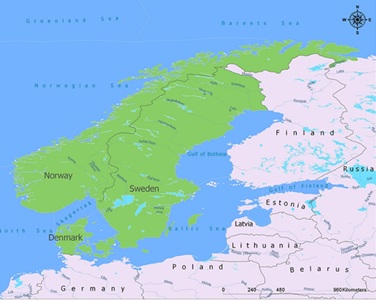By Abdikarim Buh
Scandinavia has long been painted as the world’s utopia of equality: clean streets, strong welfare systems, and a commitment to social justice. But for many non-white residents, the story is far less idyllic. Beneath the picturesque facades and progressive rhetoric, subtle—but persistent—racism shapes daily life, quietly drawing invisible lines that separate insiders from outsiders.
Imagine moving through a city where every interaction, from job applications to neighborhood greetings, feels like a negotiation with invisible walls. Résumés with foreign-sounding names are far less likely to get callbacks1. Housing is segregated, with non-white residents concentrated in under-resourced urban peripheries2. Even social programs, designed to be “universal,” are navigable only if you already understand the rules—rules shaped by centuries of cultural homogeneity3. Equality in principle is not equality in practice.
In these countries, whiteness is the default. Social networks, professional advancement, and cultural familiarity all favor those who look and act like the historical majority. Non-white residents, even when fully educated and fluent in the language, often feel like perpetual outsiders4. Integration is measured not only in legal status but in subtle cultural assimilation—conforming to norms that are tacitly coded as white.
Education, often hailed as a great equalizer, is no exception. Non-white students encounter lowered expectations, subtle stereotyping, and tracking into less rigorous programs5. Over time, these microbarriers accumulate, creating structural ceilings that limit opportunity and reinforce social hierarchies. Meanwhile, schools tout universal standards and equal access, masking the inequalities baked into the system.
Housing amplifies the problem. Urban centers are dotted with neighborhoods where non-white residents are concentrated, physically separated from the centers of economic, political, and cultural power6. These neighborhoods often face higher policing, fewer resources, and a persistent social stigma. Being present in these spaces becomes a constant reminder of marginalization.
The subtlety of Scandinavian racism makes it difficult to challenge. Microaggressions, cultural gatekeeping, and structural barriers are easily dismissed as individual incidents, rather than symptoms of systemic exclusion7. This creates a peculiar paradox: societies celebrated for fairness may simultaneously perpetuate inequality, without ever acknowledging it.
The psychological cost is significant. Non-white residents develop heightened vigilance, constantly monitoring their behavior to avoid missteps. Mental health suffers, social engagement declines, and a sense of alienation persists8. The rhetoric of equality clashes painfully with lived reality: the more the system celebrates fairness, the more glaring the exclusions become.
A Comparative Lens: Scandinavia vs. the UK and EU
When we look beyond Scandinavia to the UK and the wider European Union, a different but related picture emerges. In the UK, the post-colonial legacy creates a more visible racial hierarchy. The systemic issues are harder to deny because they intersect with language, accent, and historical memory. Non-white communities in the UK, particularly Black and South Asian residents, face well-documented employment discrimination, housing inequality, and police profiling9. The structures are overtly historical, informed by decades of imperial policy and migration patterns, whereas in Scandinavia the biases are subtler, often disguised as cultural preference or meritocracy.
The EU presents another layer of complexity. On paper, EU member states commit to anti-discrimination, freedom of movement, and inclusion10. Yet, migration crises, rising nationalism, and xenophobic political movements have exposed the fragility of these principles. In countries such as Germany, France, and Italy, non-white immigrants—particularly from Africa and the Middle East—encounter systemic barriers to employment, education, and political participation11. Scandinavia, by contrast, is often lauded internationally for its model integration policies. But the lived experience tells a different story: subtle exclusion, social invisibility, and cultural gatekeeping operate silently, often more effectively than overt prejudice.
Consider this juxtaposition: in the UK and EU, the mechanisms of exclusion are visible, debated in media and academia, and increasingly challenged in courts. In Scandinavia, the mechanisms are quieter but no less effective. The default assumptions, unspoken social norms, and the coded nature of “fit” ensure that non-white residents remain outsiders even when they appear fully integrated. In essence, Scandinavian racism is a soft power exercise—it excludes not by law, but by culture; not by ordinance, but by expectation.
Subtle Exclusion: Invisible yet Powerful
This cultural invisibility makes Scandinavian racism especially insidious. It is easy to dismiss complaints as hypersensitivity or exaggeration because there are no overt signs: no legal bans, no discriminatory legislation targeting minorities. Yet non-white residents experience the impact daily—in missed promotions, subtle social isolation, and the constant pressure to conform. The expectation to assimilate culturally, linguistically, and socially is relentless.
The Scandinavian model rests on the principle of universality, yet it fails to recognize that “universal” services are accessible primarily to those who already understand and belong to the dominant culture. Non-white residents are expected to adopt the unspoken codes of behavior, norms, and even humor12. Deviation is penalized socially, professionally, or psychologically. Equality, in practice, becomes the privilege of the culturally conforming.
Policy Implications and the Path Forward
For Scandinavia to live up to its reputation, policymakers must confront not only overt discrimination but also the subtle, everyday exclusion that shapes opportunity. Lessons from the UK and EU suggest that acknowledging structural bias, monitoring employment and housing patterns, and promoting genuine inclusion initiatives are necessary steps. In addition, Scandinavian nations must recognize that cultural homogeneity cannot be a shield against inequality.
Non-white residents must be seen not as problems to assimilate but as equal citizens with rights to shape the society they inhabit. Initiatives such as anti-bias education, equitable recruitment, and culturally responsive welfare programs are not just policy choices—they are ethical imperatives. Scandinavia cannot export its image of equality while ignoring the lived reality of exclusion within its borders.
Conclusion
Non-white residents in Scandinavia live with a paradox: celebrated globally as exemplars of fairness, yet daily negotiating subtle systems of exclusion. When compared to the UK and EU, the Scandinavian case is particularly insidious because the mechanisms are invisible, the rhetoric of fairness is strong, and complaints are often dismissed. The region’s progressive image masks a persistent struggle with cultural bias, microaggressions, and structural inequality.
Equality must not assume a default race, culture, or history. True integration requires more than policies on paper—it requires honest confrontation with cultural assumptions, systemic barriers, and social expectations. Only by acknowledging and addressing these invisible walls can Scandinavian societies genuinely uphold their ideals of equality and fairness for all residents, regardless of skin color, language, or heritage.
Abdikarim Haji Abdi Buh
Email: abdikarimbuh@yahoo.com
———
Footnotes
- Ahmed, A., Andersson, P. “Ethnic Name Discrimination in Scandinavian Labor Markets.” Journal of Scandinavian Studies in Economics, vol. 45, no. 2, 2020, pp. 211–234. ↩
- Andersson, R., et al. “Urban Segregation in Nordic Cities: Myth or Reality?” Nordic Urban Studies, vol. 12, 2020, pp. 45–70. ↩
- Brochmann, G., Hagelund, A. Immigration Policy and the Scandinavian Welfare State. Palgrave Macmillan, 2019. ↩
- Mouritsen, P. “Social Trust and Integration in Denmark: Ethnic Minorities’ Experience.” Scandinavian Political Review, vol. 42, 2017, pp. 77–102. ↩
- OECD. Equity in Education: Breaking Down Barriers in Nordic Countries. OECD Publishing, 2018. ↩
- Andersson, R., et al., 2020. ↩
- Røthing, Å., Kjørholt, A. Immigration, Integration, and Everyday Racism in Norway. Routledge, 2017. ↩
- Verkuyten, M., et al. “Psychosocial Effects of Social Exclusion on Immigrants in Northern Europe.” European Journal of Social Psychology, vol. 49, 2019, pp. 892–908. ↩
- Heath, A., Cheung, S. “Ethnic Penalties in the Labour Market: Britain’s Migrants.” Ethnicities, vol. 10, no. 1, 2010, pp. 3–27. ↩
- European Commission. Anti-Discrimination Policies in the European Union. Brussels, 2020. ↩
- Dustmann, C., Frattini, T. Immigration and the European Labour Market. Oxford University Press, 2014. ↩
- Mouritsen, P., 2017. ↩





